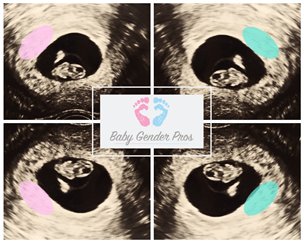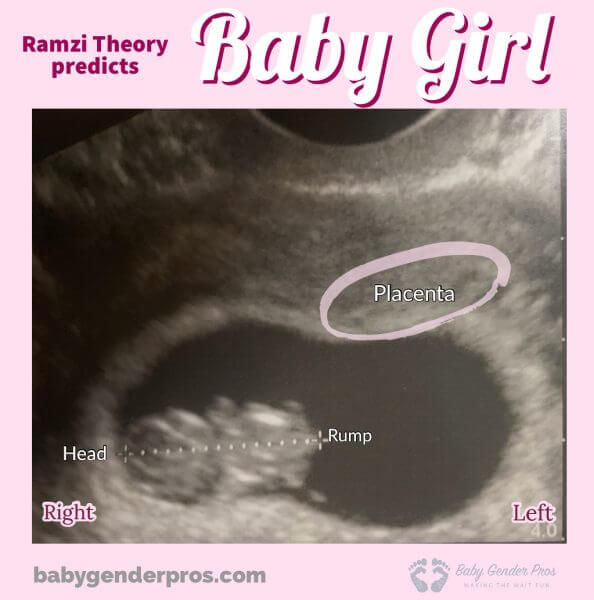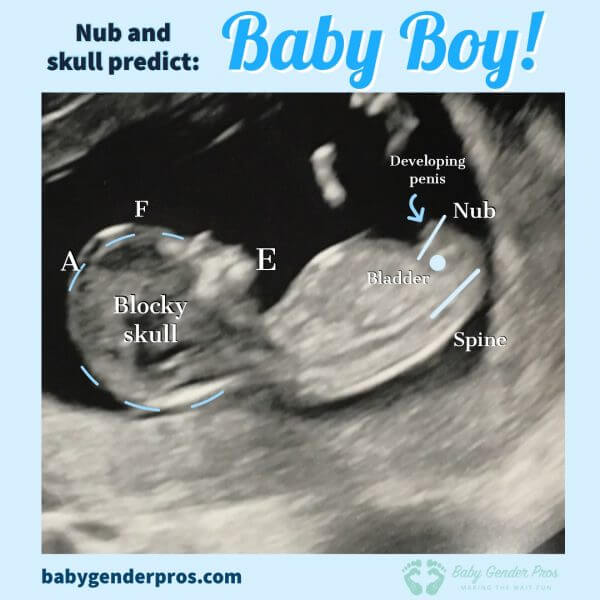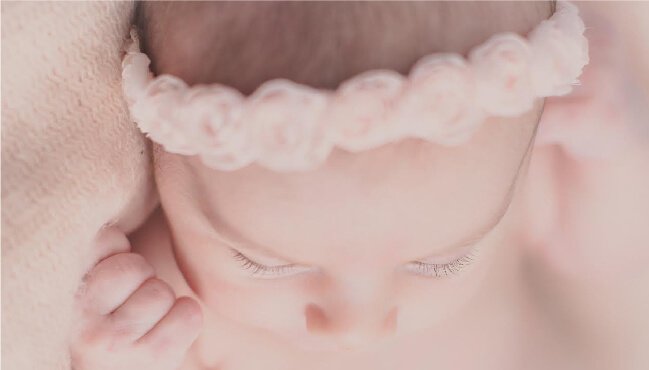The Ramzi Theory
"It's the question in most mom's minds
from the moment they see those two lines,"
- When will I know the gender?
Quick Navigation
What is the Ramzi Theory?
The Ramzi theory is a method of predicting the gender of an unborn baby using ultrasound scans. It was developed in 2004 by Dr Saad Ramzi Ismail and is based on the location of placental tissue during six-week ultrasound scans.
How accurate is Ramzy Theory?
By tracking the chorionic villi, also known as the future placenta, he gave the world a tool to very accurately reveal the gender of a baby at just 5 weeks of gestation. Although Dr. Ramzi’s theory isn’t 100% accurate, and there are multiple instances where the placenta is in a tricky spot, we believe a theory that is up to 97.5% accurate is a great foundation for a gender prediction

Why do I need professionals?
Because you can't believe everything you read online! There are several crucial aspects of this gender prediction based on placental positionthat need an expert eye. Detecting areas of growth and knowing when an images is mirrored are two of the most important ones. Do you know when to flip?
This seems to be a hot topic when it comes to Ramzi theory. The general rule of thumb seems to be that if it is an abdominal ultrasound it will be a mirrored image, but if it is taken internally it is true to side, and although that might be the case for some images, we do not believe this is a one-size-fits-all solution.
Baby Gender Pros believes that each scan should be looked at individually and look for markers. We have an extensive background in early gender prediction and are dedicated to providing new moms-to-be with the best experience possible.
What else should I know about Ramzi Method?
There is plenty to learn about this theory! Perhaps one of the most important factors to obtain a correct prediction is the gestational age of when the image was taken. Ramzi method is most accurate between the 6th and 8th week of pregnancy. Although placenta placement can be located at any point in pregnancy, it is most accurate early on because as the uterus expands the placenta moves, diminishing the chances of an accurate prediction.
In addition, sometimes the images are too zoomed out for the chorionic area to be visible, or the technician might have the brightness too high for us to see properly. The scanning plane of the ultrasound is also important. A transverse scanning plane is necessary for an accurate Ramzi method prediction. There are two other scanning planes, sagital (as if you were looking at someone from their side), and coronal (as if you were seeing someone face to face), but transvaginal ultrasound is the only place that shows you the body as if seen from above and good for gender determination.

Ramzi Theory Work Examples
Weekly Examples
Will it be a boy or a girl? This is probably the most exciting question pregnant moms have the moment they find out they are pregnant. Ramzi theory gender predictions are a great way to gain some insight into this matter from as early as your 6 week ultrasound. But is one week more accurate then the next? Let's see what the experts have to say.5 weeks ultrasound
The accuracy on Ramzi theory at less than 6 weeks of pregnancy has not yet been studied. If you read our article on the Ramzi theory, you can find that the clinical study where the Ramzi theory was developed starting at just 6 weeks along. However, this is not to say that chorionic villi cannot be detected, say at 5 weeks and 4 days. If you have an ultrasound right before the 6 week mark, it is very possible that Ramzi theory accuracy will be the same as it is at 6 weeks.6 weeks ultrasound
The official study consisted of over 5,000 expectant mothers that were between the 6th and 8th week of pregnancy. This makes a 6 week ultrasound a great candidate for an accurate gender prediction. Please note that being able to see the full gestational sac is very important for an accurate gender prediction.
7 weeks ultrasound
At this early stage in pregnancy, many women have already taken a pregnancy test but are still waiting for their first ultrasound. However, if an early ultrasound has been done, Ramzi theory at 7 weeks of pregnancy is accurate, and a mother will likely be able to see a yolk sac as well as the growing baby.
8 weeks ultrasound
The 8th week of pregnancy is when most women go in for their first pregnancy visit and have their first ultrasound! At this age, it should be easy to detect a heartbeat as well as possibly distinguish the head and rump of the baby. Ramzi theory accuracy is at its peak during the 8th week.
9 weeks ultrasound
Due to the controlled study only looking at women from 6-9weeks of pregnancy, anything after that is "unknown," however, we do know that every pregnancy is different and that every baby develops at a different speed. This means that the development of a baby at 9 weeks and 3 days might be the same as someone else's at 8 weeks and 6 days. We believe Ramzi theories are extremely accurate at 9 weeks of pregnancy.
10 weeks ultrasound
As previously stated, there is no evidence of the accuracy of the Ramzi theory at 10 weeks of pregnancy. At this stage, the yolk sac may no longer be visible, but you can still easily see which side the placenta is developing on. We believe 10 weeks is the last stage that the Ramzi theory maintains a great deal of accuracy.
11 weeks ultrasound
Nearing the second trimester, this week of pregnancy is able to show us good skull structure and the beginnings of a genital tubercle. This means that, although the accuracy of the Ramzi theory at 11 weeks is not high, we are able to combine it with other gender prediction methods like nub and skull.
12 weeks ultrasound
As the uterus grows to fit the growing baby, the side on which the placenta started developing may no longer be clear. However, a 12 week ultrasound is the start of high accuracy for a nub prediction! Learn more about this theory that can predict the gender of your baby 99% at only 12 weeks.If you have any ultrasounds from your pregnancy and you do not know the gender of your baby, we invite you to try our gender prediction services here! We provide fun and insightful predictions that will make you feel closer to your baby, and make the wait fun!
Baby Boy & Girl Pregnancy Examples
Ramzi Theory Prediects: Boy!
Ramzi Theory Prediects: Girl!
How to Use the Ramzi Theory?
The Ramzi Theory is based on a simple concept: if the embryo implants on the right side of the uterus, it’s likely a boy; if it implants on the left, it's probably a girl. To use this method, you can view your ultrasound images and check where the placenta is located. If it is on the right side of the uterus, there’s a high probability that it’s a boy; if it's on the left, it's likely to be a girl. You may also have to check for the presence of a “polar body”, indicating whether the embryo has XY chromosomes.
Is the Ramzi Theory Accurate?
By tracking the chorionic villi, also known as the future placenta, Ramzi gave the world a tool to very accurately reveal the gender of a baby at just five weeks of gestation. Although Dr Ramzi’s theory isn’t 100% accurate, and there are multiple instances where the placenta is in a tricky spot, we believe a theory up to 97.5% accurate is an excellent foundation for a gender prediction.
What else should I know about the Ramzi theory?
There is plenty to learn about this theory! One of the most important factors in obtaining a correct prediction is the gestational age when the image was taken. Ramzi method is most accurate between the 6th and 10th week of pregnancy. Although placenta placement can be located at any point in pregnancy, it is most accurate early on because as the uterus expands, the placenta moves, diminishing the chances of an accurate prediction.
In addition, sometimes the images need to be zoomed out for the chorionic area to be visible, or the technician might have a high brightness for us to see correctly. The scanning plane of the ultrasound is also important. A transverse scanning plane is necessary for an accurate Ramzi method prediction.
There are two other scanning planes, sagittal (as if you were looking at someone from their side) and coronal (as if you were seeing someone face to face). Still, transvaginal ultrasound is the only place that shows you the body as seen from above and is suitable for gender determination.
Know Your Baby Gender Today!
The Ramzi theory is a scientifically proven system for gender prediction, with an accuracy rate of 97.5%. At Baby Gender Pros, we utilize the Ramzi theory to accurately determine the gender of your baby at only six weeks of pregnancy. Our team has extensive education and experience in this field and is dedicated to quickly providing accurate results. The next time you or a friend wants to know your baby's gender through the Ramzi theory, call us! We are here to provide you with reliable and accurate results.
It’s important to remember that while all these methods offer clues as to what gender your baby may be, none are 100% accurate. The only way to know definitively is to get an official confirmation from a doctor during an ultrasound or a blood test. Everything is just speculation and should be taken with a grain of salt.
Ramzi Theory FAQs
Other gender prediction theories
Submit your review | |
i submitted for ramzi at 8 weeks and nub at 11 weeks and both predictions were girl! we just got our bloodwork back they were right, after 3 wonderful baby boys we are having a baby girl! i alamo submitted a 12 week scan for my previous pregnancy and they were right in predicting a baby boy!
I did this just for fun, since I was curious. The nub and skull theory predicted we are having a girl, and we just found out today that we are having a girl!
Used all 3 theories all came back girl guesses, ultrasound confirmed a boy.
I was so anxious to know what my baby was as this is my first and last lol. Husband was convinced it was a boy, I sent my ultrasound just out of curiosity and the experts said it was a girl. I had the blood work test and they were right!!! A sweet girl 💕
mande mi ecografia de 10 semanas y ahora ya con 16 semanas me confirmaron que el bebé será niño!!!
realmente funciona 🙂
Paid for the Ramzi for my daughter. We were told a girl. She had a blood test done and was told a boy. She had an ultrasound and it confirmed a boy.
Never tried this before but wanted to after 3 boys to see if we had a chance of a girl. Was told it’s a girl, I didn’t believe it I thought i won’t get my hopes up, my gender scan said girl, and when born was born a girl!
Can’t believe and recommend anyone who wants to guess
Baby Gender Pros predicted I was having a girl based on Ramzi theory and I am happy to report that they were right!
The gender pros guessed that my twins were transverse and mirrored images and that both placentas were forming on the right, well... it turns out that it IS two boys and this was confirmed by blood DNA test and ultrasound.
I sent in my 12 week ultrasound and was told possibly a girl, and you were right, we are expecting a GIRL!! 🎀
I think the predictions for this theory are sound however, in my case they are correct. I have a 1.5 year old boy already and desperately wanted a little girl to complete my family so when you guys sent me my results and they said girl for both of the photos I submitted I was thrilled! I knew of course this is just a theory and not a replacement to an Ultrasound but, it gave me some hope my sneak peek results were wrong. I ended up going for a 16 week ultrasound and they determined that it was indeed a girl! We are very excited of course and can't wait to meet her. I think i will be the method I use for future children.
Sendt one to another website from week 6, they said boy. But this site from week 8+5 said girl. So im excited to see Whois right. Will update when i know 😀 just for fun, worth the money anywho
Had Girl guesses on all theories and has now been confirmed that we are having a girl!
Paid for the nub theory and got baby girl,
We decided to wait until I gave birth to find out and it was indeed a little girl!
Would recommend this service!
Looks good for me
They told me I was having a boy and I just got my nipt results today and I’m having another girl
Very disappointed but I actually did it for fun and it was!
I send them all my transvaginal ultrasound they said it’s girl but I just find out September last week it’s girl I am happy! I always want a girl
Im absolutely over the moon both myself and friend submitted our scans on exact same day we got the results back straight away and have both been confirmed the gender which was predicted. I honestly cant belive how accurate this was for us . Thankyou so much
Just to let you know your prediction right! I done my 20 weeks ultrasound it’s a baby girl.
All your theories come up right! .skull,nub and placenta.
Thanks
Sent in 2 scan photos from 10weeks 5 days and 2 from 13weeks 5 days.. predicted boy but just found out it’s a boy! Would trust this company again!, do not waste your money on sneak peek!!














